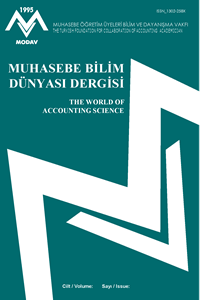Abstract
A correct valuation of loans, the largest asset class on on banks’ balance sheets, is critical for the resilience of the banking system. A sound valuation of loans on the balance sheet is closely linked with the provisioning approach adopted as well as its timing. This topic has once more attracted attention with bank failures and their cost to economy during the recent financial crisis. IAS 39, the related accounting standard, has been severely criticized for aggravating the financial crisis by delaying the recognition of loan losses. Finally, the International Accounting Standards Board has been compelled to review the issue of provisioning and thereby developed a new standard, IFRS 9, to replace IAS 39. The new standard is going to be effective in 2018.This paper examines the expected loss approach of IFRS 9 regarding provisioning.
Keywords
References
- Basel Committee on Banking Supervision.2015.The Interplay of Accounting and Regulation and Its Impact on bank Behaviour: Literature Review, Bank for International Settlements.
- Beatty, A., S. Liao 2011.Do Delays in Expected Loss Recognition Affect Banks’ Willingless to Lend? Journal of Accounting and Economics, 52(1).
- Demir, V. 2015.TFRS/UFRS Kapsamında Finansal Araçlar, Nobel Akademik Yayıncılık.
- Expected Loss(EL) Calculation, riskarticles.com/expected-loss-elcalculation.
- Gaston, E.,I. Won Song 2014. Supervisory Roles in Loan Loss Provisioning in Countries Implementing IFRS, IMF Working Paper.
- Laux, C., C. Leuz 2010. Did Fair Value Accounting Contribute to the Financial Crisis? Journal of Economic Perspectives, 24(1).
- Novotny-Farkas.2015. The Significance of IFRS for Financial Stability and Supervisory Rules, European.
- Parliament Policy Department A: Economic and Scientific Policy.
- Samuel, K., P. Richardson, K. Rismanchi K ve K. Sen Understanding the Fair Value of Banks’ Loans, Financial Stability Paper No.31, Bank of England.
- Tan Liong Tong.2015. A Review of The Expected Credit Loss Model of IFRS 9, Financial Instruments
- www.masb.org.my/
- Yanık, S, Y. Özerhan 2015. Açıklamalı Örnek Uygulamalı TMS-TFRS, TÜRMOB.
Abstract
Banka bilançosundaki en önemli varlık kalemi olan kredilerin değerinin doğru belirlenmesi bankacılık sisteminin sağlıklı işleyişi açısından önemlidir. Kredilerin bilançodaki değerinin belirlenmesi de kredi zararları için nasıl ve ne zaman karşılık ayrılacağına bağlıdır. Yakın geçmişte yaşanan finansal kriz çerçevesindeki banka iflasları ve bu iflasların ekonomik bedeli, dikkatleri bir kez daha bu konuya yöneltmiştir. Konuya ilişkin muhasebe standardı UMS 39, kredi zararlarının muhasebeleştirilmesini geciktirerek krizi tetiklediği gerekçesiyle yoğun eleştirilere maruz kalmıştır. Sonuç olarak, Uluslararası Muhasebe Kurulu karşılık ayırma konusunu yeniden ele almak zorunda kalmış ve UMS 39’un yerine yeni bir standart geliştirmiştir. UFRS 9 olarak anılan bu standart 2018 yılında yürürlüğe girecektir. Bu çalışmada UFRS 9’un yeni değer düşüklüğü yaklaşımı olarak adlandırabileceğimiz beklenen kredi zararları modeli değerlendirilecektir.
Keywords
References
- Basel Committee on Banking Supervision.2015.The Interplay of Accounting and Regulation and Its Impact on bank Behaviour: Literature Review, Bank for International Settlements.
- Beatty, A., S. Liao 2011.Do Delays in Expected Loss Recognition Affect Banks’ Willingless to Lend? Journal of Accounting and Economics, 52(1).
- Demir, V. 2015.TFRS/UFRS Kapsamında Finansal Araçlar, Nobel Akademik Yayıncılık.
- Expected Loss(EL) Calculation, riskarticles.com/expected-loss-elcalculation.
- Gaston, E.,I. Won Song 2014. Supervisory Roles in Loan Loss Provisioning in Countries Implementing IFRS, IMF Working Paper.
- Laux, C., C. Leuz 2010. Did Fair Value Accounting Contribute to the Financial Crisis? Journal of Economic Perspectives, 24(1).
- Novotny-Farkas.2015. The Significance of IFRS for Financial Stability and Supervisory Rules, European.
- Parliament Policy Department A: Economic and Scientific Policy.
- Samuel, K., P. Richardson, K. Rismanchi K ve K. Sen Understanding the Fair Value of Banks’ Loans, Financial Stability Paper No.31, Bank of England.
- Tan Liong Tong.2015. A Review of The Expected Credit Loss Model of IFRS 9, Financial Instruments
- www.masb.org.my/
- Yanık, S, Y. Özerhan 2015. Açıklamalı Örnek Uygulamalı TMS-TFRS, TÜRMOB.
Details
| Primary Language | Turkish |
|---|---|
| Subjects | Business Administration |
| Journal Section | MAIN SECTION |
| Authors | |
| Publication Date | March 31, 2016 |
| Submission Date | January 23, 2015 |
| Published in Issue | Year 2016 Volume: 18 Issue: 1 |


